And they say nobody walks in L.A.
March 2, 2012
There’s nothing like a brisk evening stroll to pump up your fitness. Ask Rick Albrecht. This week, he’s been averaging seven miles daily. In steel-toed boots. In the middle of the night.
Call it the Rock Walk. In a regimen that’s impressive even by Southern California standards, Albrecht and his coworkers have spent virtually every night since Tuesday on foot next to The Rock, carefully monitoring its 105-mile journey to LACMA.
“We may not look it,” the white-bearded 52-year-old joked as he waited to hit the road in a reflective vest and hardhat, “but we can out-walk just about anybody. Just by the nature of what we do, no matter what age we are, we’re in pretty good shape.”
A supervisor for Portland, Ore.-based heavy haul transporter Emmert International, Albrecht said that, even with breaks, he will personally cover 70 miles or more on foot by the time the boulder is delivered to the backyard of the museum in the wee hours of March 10.
And he’s not alone: More than a dozen crewmen will be walking beside him, escorting the 340-ton centerpiece of “Levitated Mass,” artist Michael Heizer’s new LACMA installation.
Although a handful of Emmert employees will be driving the massive red transport mechanism—a system of tractors, beams and cables within which the shrink-wrapped hunk of granite has been painstakingly cradled—the majority will be walking with radios beside the precious cargo, either remote-controlling various dollies or watching for potential slippage.
“Some jobs, you can ride alongside and watch from a pickup, but this is a specialized thing,” says crewman Joe Schofield, adding that he has mentally prepared himself to walk the entire distance, if necessary. “There’s so much going on that you have to walk or you can’t see it all.”
Schofield, also in his 50s, said the job has made him far more fit than most of his middle-aged neighbors in suburban San Gabriel, where he lives when he’s not traveling for his employer.
“I’ll do 30 miles on a bike when I’ve got nothing else to do,” said the bespectacled crewman, who says he thinks nothing of riding his beach cruiser to Long Beach and back just to see friends.
“People here say, ‘Oh, I’ve got to get to the gym.’ Oh yeah? Well, come out here and work with us a day. You won’t need to. When you’re handling big chains and moving blocks and walking five or ten miles a day, believe me, it does its thing to you.”
The boulder and its transporter together weigh about 1.2 million pounds; the move to LACMA from the Riverside County quarry where The Rock was blasted six years ago from the side of a mountain has been spread over 11 nights.
The cavalcade, which will move on surface streets through 22 cities and four counties, can only move between 10 p.m. and 5 a.m., and will not travel on Sunday. Its route is circuitous to avoid overpasses and bridges.
Five miles per hour is as fast as the apparatus will travel, so the pace isn’t bad, notes supervisor Charlie Prebble. And, he notes, the miles tend to fly by because the assignment is so high profile and critical. The transportation alone is costing millions of dollars, underwritten by corporate donor Hanjin Shipping.
Indeed, he says, this job’s workout is mild compared, say, to the 700-mile move they once did between Idaho and Montana, or the 14-miles they trekked in work boots, much of it in the sand, during a recent slow-speed delivery to the nuclear plant in San Onofre.
“You don’t get tired,” he says. “You can’t. You gotta keep moving. You only have from 10 to 5, so you’ve got to make the best of what you’ve got.”
Albrecht, whose brother Mark is the general manager of the project, said his family has been in the moving business for generations. “My father started out moving houses,” he says.
So what are Albrecht’s heavy-haul fitness secrets? Has he developed a stretching routine before his shift starts?
“Nope.”
Does he carbo load?
“Had a nice steak lunch today, that’s about it.”
What about blisters?
“After a while, you callous up.”
What does he do for variety in his off-hours?
“Ride Harleys.”
And when the sun comes up and another day of his marathon is over?
“You sit down and take your boots off and—ahhhhhhhhhhhhh. That feels good.”
Posted 3/2/12
Pushing jobs, not condos, at Universal
March 1, 2012
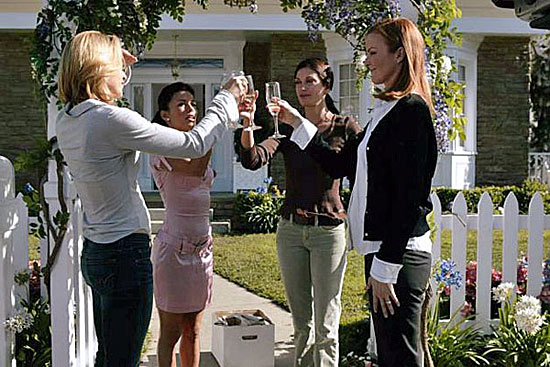
Parts of Universal's backlot, including "Wisteria Lane," above, would be moved under home plan. Photo: AP/ABC
NBC/Universal should drop plans to build nearly 3,000 housing units on its backlot, Supervisor Zev Yaroslavsky said this week in a strongly-worded letter to studio chief Ron Meyer.
While Yaroslavsky has previously criticized the scale of the Evolution Plan, this is the first time he has pushed the studio to drop the housing component altogether. Doing so, he said, would better position Universal for a future in which it remains a strong entertainment industry contributor to the L.A. economy.
“Abandoning that portion of your plan would make long-term economic sense for this region by ensuring that Universal will remain a full-service motion picture and television production campus and a major contributor to our regional economy,” Yaroslavsky said in his letter.
Building some 2,900 condos, lofts, townhouses and apartments on 124 acres of Universal’s property would cut into the studio’s backlot and require relocation of its famed “Psycho” house. It also would mean uprooting Wisteria Lane, the setting for “Desperate Housewives,” now in its final season, and Falls Lake, where movies including “Jaws” were shot.
Even without the housing element, the 20-year Evolution Plan remains a large-scale blueprint for how the studio proposes to grow on its 391-acre Universal City site.
The Entertainment Evolution portion of the plan calls for an improved studio tour, a 500-room hotel for CityWalk, upgraded movie theaters, restaurants and stores, and new theme park attractions. (Even as the Evolution Plan has been moving through the system, at least one big new attraction, the Wizarding World of Harry Potter, has been announced, although it is not expected to open for several years.)
Meanwhile, the Studio District Evolution component of the plan includes more than 308,000 square feet of new production space, 437,000 square feet devoted to new production support facilities and nearly 500,000 square feet of new office space.
In his letter, Yaroslavsky said that those new elements, along with current operations, would create more than 34,000 permanent new jobs, whereas just building homes would yield only 2,600. And construction and construction-related jobs, he said, would still number about 15,000 without the housing component.
“In short, the expansion of the studio’s production facilities and related entertainment uses will produce far more economic benefit to our region than the apartments and condominiums that are proposed to be built under the Evolution Plan,” Yaroslavsky said.
In fact, he said, establishing a large new residential neighborhood just feet from an active entertainment studio and theme park would only worsen complaints about noise, and, in time, could force the studio to cut back on production. That, in turn, could lead to a loss of entertainment industry jobs: “None of us could possibly want such a result,” Yaroslavsky said.
The company said in a statement it would consider Yaroslavsky’s comments, along with those of community members, as part of the ongoing environmental review process. A final environmental impact report is now being prepared. That report, along with other permits, must be approved at multiple levels of city and county government before the Evolution Plan can move into action.
Richard Bogy, executive vice president of Communities United for Smart Growth, a coalition of neighborhood and business groups affected by the Universal plan, said Yaroslavsky’s letter to Meyer “really says everything that we agree with.”
Using Universal’s land to grow its entertainment businesses makes more sense than allowing it to be used for housing, Bogy said: “It’s valuable land to the entertainment industry.”
While questions remain about the overall project’s impact on infrastructure, transportation and traffic, Bogy said, dropping the home-building plan would go a long way toward assuaging his group’s concerns.
“The one really big stumbling block in the plan,” he said, “has been the housing.”
Posted 2/1/12
Annual report comes alive
March 1, 2012

The county's latest Annual Report has gone digital, with user-friendly videos and social networking tools.
If the words “Annual Report” make you reach for the snooze button, has L.A. County got a wake-up call for you.
For the first time ever, the county’s Annual Report is being presented in a user-friendly digital format that features county leaders—from the Board of Supervisors to the Treasurer-Tax Collector—speaking directly to the public in short, informative videos. Feel like talking back? Each segment includes an array of contact information for getting in touch with county departments, and is also readily shared on Twitter, Facebook and other social media platforms.
Updated 7/11/12: The League of American Communications Professionals recently recognized the county’s Annual Report in its 2011 Vision Awards with five honors, including a Platinum Award for the best large government report. The international contest drew 5,500 entries from 24 countries.
One of the report’s most distinctive features is a series of videos produced by the LA County Channel, including a piece on Melinda Star Guido, the world’s third-smallest baby, born at County-USC Medical Center last year.
You might call it an annual report for the YouTube generation. But it also includes all the substance the county has traditionally provided, including a downloadable print version, complete with pie charts on the county budget.
“In past years we only had a paper report and printed just a few thousand copies,” David Sommers, the county’s acting director of public affairs, said in a statement. “That’s a fraction of the copies needed for a potential audience of 10 million county residents, or even our own 90,000 employees.”
Check out the county’s 2011 Annual Report here.
Posted 3/1/12
Pluto-killing scientist talks
February 29, 2012

Poor little Pluto never saw it coming. Find out why Dr. Michael Brown pulled the plug on the one-time 9th planet.
Still miffed that Pluto’s not a planet anymore? The man responsible is coming to the county’s Natural History Museum to give his side of the story.
“I‘m ready for them to come in with rocks and throw their drinks and attack,” said Dr. Michael Brown, who’ll appear at the museum on Friday, March 2. “I know they are all sad about it.”
In 2005, Brown announced the discovery of Eris, an object larger than Pluto at the edge of the solar system. His team’s findings led the International Astronomical Union to revise the definition of “planet.” This demoted Pluto to a “dwarf planet,” causing an uproar among many who knew and loved the one-time ninth planet.
“Some of it is just funny,” Brown said of the backlash. “And some of it is just downright mean, which is almost funnier.”
Brown is a professor of planetary astronomy at the California Institute of Technology. His work has been featured in publications including the New York Times, The New Yorker and Discover magazine. In 2006, he was honored as one of Time Magazine’s “100 Most Influential People” and one of Los Angeles Magazine’s “Most Powerful Angelenos” for his discoveries. That same year, Wired Magazine named him one of the “Top Ten Sexiest Geeks.”
He told Wired in 2010 that even his 5-year-old daughter was perturbed by Pluto’s planetary downgrade. “She has learned from general discussions that I killed Pluto and that killing is bad. Therefore, I’ve done something bad, and so she’s kind of mad at me,” he said.
Brown, who’s also the author of the book “How I Killed Pluto and Why It Had It Coming,” hopes that by the end of the discussion people will be ready to lay down their torches and pitchforks.
“One of the things that will surprise people the most is how reasonable the decision to demote Pluto was,” he said. “I think they will leave and decide they should be mad at Pluto, not me.”
Brown’s talk, called “Why Pluto Had to Die,” starts at 6:30 p.m. It’s part of the museum’s “First Fridays” series combining science and innovative music. The programs aim to attract young and not-so-young adults to the museum, even though the field trips of their youth may be long past.
The tunes kick in at 5:30 p.m. with KCRW DJs Anthony Valadez and Chuck P. At 8 p.m. EMA takes the stage, combining a free jazz lyrical style with fuzzy, droning guitar rock reminiscent of Sonic Youth.
Zola Jesus, the night’s headliner, is a self-made, up-and-coming electronic pop musician at the age of 22. Her compositions pair trance-inducing electronic sounds with haunting, almost-mournful vocals. She goes on at 9:15 p.m. amid the dioramas of the North American Mammal Hall.
General admission to all of it is $18, and free for Universityof Southern California students. The museum is located at 900 Exposition Boulevard in Los Angeles. Parking is $10, or plan to get there with Metro. While advance tickets are sold out, don’t worry—same day tickets will be available at the south entrance starting at 5 p.m.
Posted 2/29/12
Night closures of freeway, Wilshire planned (updated)
February 29, 2012
The Mulholland Bridge is at it again. The freeway-spanning overpass that brought you Carmageddon is being rebuilt after last summer’s demolition watched ‘round the world.
And that means some highly visible construction supports need to be installed starting Friday, temporarily changing the look of the bridge and requiring six nights of freeway closures (although only in one direction at a time.)
The iconic bridge with the imposing 237-foot-long central span was designed without center support columns. So, unlike the Sunset and Skirball bridges that also are being demolished and rebuilt for the project, the Mullholland Bridge requires some extra TLC, not just to tear down but also to build back up.
Workers in early February installed a temporary 64-foot-high central support structure (known in the trade as falsework) to shore up the bridge and allow for the reconstruction of the south side of the structure torn down during Carmaggedon.
More of the temporary falsework, in the form of six steel girder beams, each more than 100 feet long, will be installed starting Friday. Plywood will then be placed above the beams and used to form the roadway that will run across the bridge, which originally opened in 1960.
While all that’s going on overhead, the 405 Freeway will be closed from Getty Center Drive to the 101 Freeway so that the work can proceed safely.
The first overnight closures will affect the northbound freeway, and will take place on Friday and Saturday, March 2 and 3.
Then the same stretch will be closed in the southbound direction on the nights of Monday and Tuesday, March 5 and 6.
The work is expected to conclude with another two-night southbound closure, again on the stretch running from the 101 to Getty Center Drive, on Monday and Tuesday, March 12 and 13.
In each case, the drill is the same: some ramps will begin closing as early as 7 p.m. and some lanes will go out of commission beginning at 10 p.m. The full shutdown of freeway lanes will take place from midnight to 5 a.m.
(For updates on the closures and for detour information, check the project website or follow it on Facebook, Twitter or Nixle.)
Updated 3/2/12: Metro announced Friday that Wilshire Boulevard at Sepulveda also will be closing from 8 p.m. to 6 a.m. on a series of upcoming nights starting Monday, March 5. The closures are needed for some advance work on widening the portion of the 405 that crosses Wilshire. Details are here.
The work is all part of the massive, $1.03 billion project to construct a 10-mile northbound carpool lane on the 405, along with a series of modernizations and improvements, including “flyover ramps” at Wilshire Boulevard.
Some of the complexities of demolishing and rebuilding the Mulholland Bridge could have been avoided under a time- and money-saving plan that would have built an entirely new bridge before tearing down the old. But that idea, although popular with many on the project’s Community Advisory Council, was scuttled after some neighborhood groups filed objections.
The date for Carmageddon, The Sequel, in which the north side of the Mulholland Bridge will come down, requiring a shutdown of the entire freeway in both directions sometime this summer, has not yet been set.
Posted 2/29/12
A farewell to two master musicians
February 29, 2012
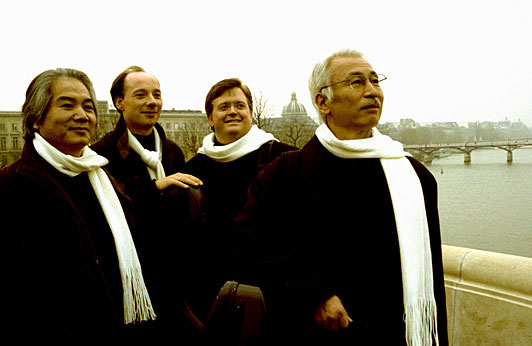
The Tokyo String Quartet is getting ready to say goodbye to two of the legendary ensemble's players.
The two longest-playing members of the Tokyo String Quartet are about to depart after decades with the ensemble. Before that happens, the Broad Stage of Santa Monica is offering an opportunity to hear the current lineup, world-renowned for their precision and prowess.
Violist Kazuhide Isomura is the last remaining original member of the quartet, founded in 1969 at the Juilliard School of Music. He and second violinist Kikeui Ikeda, who joined in 1974, have announced that they will retire in 2013. Since they joined the quartet, it has performed thousands of concerts, guest-starred on Sesame Street, released dozens of recordings and become the quartet-in-residence at the Yale School of Music.
This Saturday, March 3, at 4 p.m., the group will perform a program of Haydn, Grieg and Debussy on the so-called Paganini Quartet—Stradivarius instruments named after the 19th century virtuoso who once owned them. Tickets to the concert range from $32 to $75, and are available online or by calling (310) 434-3200. Directions to the Broad Stage are available on the website.
Posted 2/29/12
Geffen’s gone crazy for kids
February 29, 2012
It’s always a good idea to use jugglers, stilt-walkers and puppets if your goal is to keep children in their seats.
At the Geffen Playhouse, the quirky Troubadour Theatre Company will pull rabbits out of every imaginable hat for Funky Punks!—a live, circus-themed series of sketches. The production is part of the playhouse’s “Saturday Scene,” a set of performances specifically tailored for families. Complimentary snacks will be served after the show.
The bulk of the programming at the UCLA-affiliated Geffen Playhouse is classic and contemporary plays for adults. Saturday Scene is part of the playhouse’s education and outreach efforts, which are designed to foster an appreciation of theater in young people and the community.
Funky Punks! takes the stage Saturday, March 3, at 11 a.m., and is recommended for children ages 5 through 11. Tickets are $15 for adults and $10 for children. The Geffen Playhouse is located at 10886 Le Conte Avenue in Westwood.
Posted 2/29/12
Thoughts on a rock star
February 29, 2012
During the next week, you’ll surely see lots of pictures of a huge red contraption hauling a shrink-wrapped boulder along the streets of four counties, inching its way at night toward the Los Angeles County Museum of Art.
And I suspect some of you will be asking yourselves (and others), why all the fuss over a 340-ton chunk of granite from some Riverside quarry? This, you call art?
My answer to that, in a word, is yes. That said, I do understand some of the skepticism, which is why I thought I’d share with you what I find so inspiring—so artistic—about this monumental, privately-funded project.
The boulder is just one facet of a work called “Levitated Mass,” conceived by Michael Heizer, the reclusive Nevada artist who has dedicated himself for decades to massive undertakings using the offerings of the earth as his primary media. At LACMA, The Rock, as it has come to be called, will be positioned over a concrete trench that allows visitors to walk underneath, creating a sense that the boulder is levitating.
“Levitated Mass” and Heizer’s other big, outdoor projects are reminders to me of how small, physically, we are in the scheme of things. They almost demand humility and introspection. Indeed, the whole oversized effort—the transport, the engineering required to install the rock at LACMA, all of it—is part of the art to me.
Some people, of course, will always view Heizer’s LACMA work as simply a big rock. But to others, including me, it will represent something far more emotional and soulful. And that’s as it should be given the subjective nature of art—or, in this case, the art of nature.
The other night, in the chill air of Riverside County shortly before The Rock finally hit the road, I was struck by how the ambition of one man’s vision could not be realized without the specialized collaboration of so many others—the quarry workers, the hard-hatted crew responsible for moving the rock, the beaming museum executives who pulled together the funding. Then there were the scores of spectators who knew they were witnessing something special, something transcendent.
“This is a once in a lifetime experience, to see something like this,” said one. “This has been here for like 20,000 years, and now it’s art.”
My thoughts exactly.
(Click here for a map of where you can see The Rock as it makes its journey to LACMA.)
Posted 3/1/12
Finally, “The Rock” meets the road
February 29, 2012
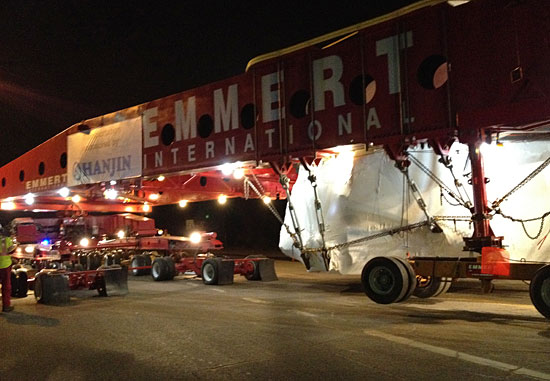
The Rock begins its nine-day journey to LACMA, where it will be used in Michael Heizer's "Levitated Mass."
With a round of applause and two mighty blasts of a truck horn, The Rock finally hit the road at 10:37 p.m. on Tuesday in what may be the most talked about slow-speed odyssey since O.J. Simpson’s Bronco snaked through the Southland’s streets.
The 340-ton boulder that is the centerpiece of “Levitated Mass,” Michael Heizer’s new LACMA installation took seven minutes just to make it out of the Stone Valley Materials Inc. quarry in Riverside County.
A crowd of several hundred cheered and shivered as the behemoth began its epic journey. Covered in white shrink-wrap to ward off taggers, it rode on a massive red transporter and looked, under the vehicle’s bright lights, like a well-lit iceberg.
“This is a once in a lifetime experience, to see something like this,” said Stan Ortman of Chino Hills, who spotted the boulder on his way home from work and stopped. “This has been here for like 20,000 years, and now it’s art.”
The Rock, as it affectionately came to be known, has been waiting for what seems like eons to head out to LACMA, where it will be positioned over a concrete trench in a manner that will make it look as if it is levitating.
That Thursday night’s festive send-off even happened is a bureaucratic miracle of sorts. Although millions of dollars in transportation costs are being underwritten by corporate donor Hanjin Shipping, the move required delicate and sometimes contentious negotiations with 22 cities and four counties. As early as Tuesday morning, some municipalities were still demanding various concessions from the museum in exchange for permits.
For the next nine days, The Rock will be cradled on its 299-foot-long, 27-foot-wide steel carriage as it travels on surface streets at speeds of less than 5 mph. Crews of workers will rush ahead to make sure utility and power lines are kept clear.
The Rock reached its first stop before dawn at a wide-open strip of private property at Mission Boulevard and Bellegrave Avenue in Glen Avon. It will spend all of Wednesday there before setting off in darkness on its next leg, which, if all goes according to plan, will get it as far as Mission Boulevard and Grove Avenue, near LA/Ontario International Airport.
(For a full LACMA “Gawker’s Guide” to The Rock’s trip, click here.)
On Tuesday night, several hundred people came by during the evening to bid The Rock bon voyage, including LACMA Director Michael Govan, Supervisor Zev Yaroslavsky, Jurupa Valley Mayor Laura Roughton, and Dan Johnston, who, as project manager for the quarry’s former owner, sold the boulder to Heizer.
Govan said that, when Heizer first set eyes on granite boulder, which had been dynamited from the side of the mountain, “he called me… and said it was the most beautiful rock he’d ever seen.”
Although Heizer, who is famously reclusive, was not in attendance Tuesday, Govan said he’d seen him earlier in the day at the artist’s home in Nevada. “He said there was nothing he could do to help move the rock,” Govan explained, “so he wouldn’t be here. But he’s excited. When we first started this, we weren’t sure it would actually happen. The engineering, the organization, all the permissions—there were a lot of doubters. But now it’s happening, and it’s going to be a real gift to the public. It’s going to be great.”
The crowd tended to agree.
Daniel Ponti, a Glen Avon photographer, said he had been “waitin’ months for that darn thing to move,” and checking its progress daily. Saul Gomez, 14, of Sunnyslope, said his father had alerted him to The Rock’s presence and sent him to look with his mom and his sister Samantha. “I’ve never seen anything like it,” the boy said. “It’s huge!”
Others were as amused as they were awestruck.
“Pretty big rock, huh?” observed Dave Sharp of nearby East Highland, a union employee whose wife, Leslie Hubbs, said she was the niece of the quarry’s former owner. “I think it’s crazy. It’s great, but it’s nuts.”
Stephen Vander Hart, the quarry’s current owner, said the boulder had been loaded since December and ready to roll since Saturday morning. All week, he said, bystanders had been coming by to check it out.
As the sun set Tuesday, commuters and neighbors gathered to pose with the boulder and buy Southern-style barbecue from an enterprising local chef. “We’re re gonna miss it,” said Vander Hart. “It’s pretty impressive. I think people are gonna get a kick out of seeing it out there on the road.”
The Rock will travel only at night. In addition to the first two stops in Riverside County, it will stop in Diamond Bar, Rowland Heights (it will be across the street from Pathfinder Community Regional Park both Saturday and Sunday), La Mirada, Lakewood, Long Beach’s Bixby Knolls neighborhood, Carson, and Los Angeles (near Exposition Park).
It will rest during the day and arrive at LACMA on Friday sometime before dawn. There, it will be positioned over the other half of Heizer’s artwork—a massive concrete trench on the Resnick Pavilion lawn.
Posted 2/29/12




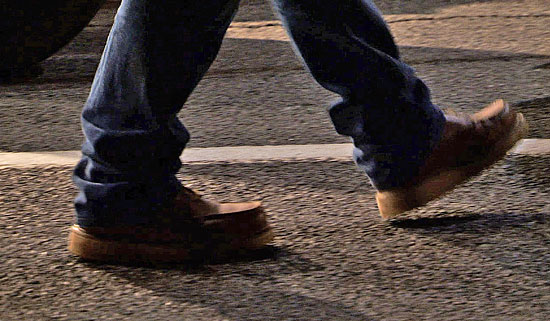
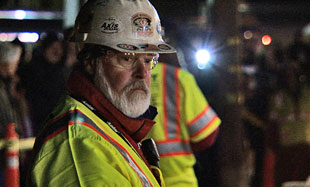
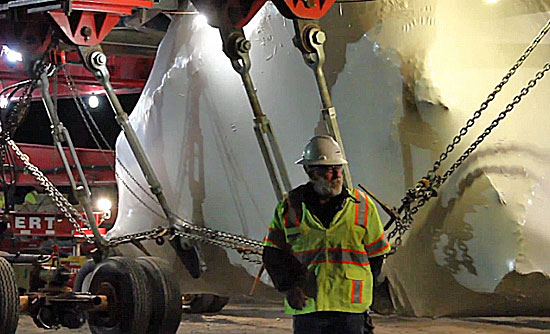
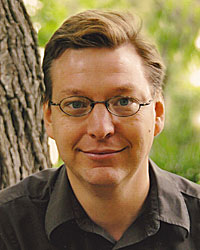
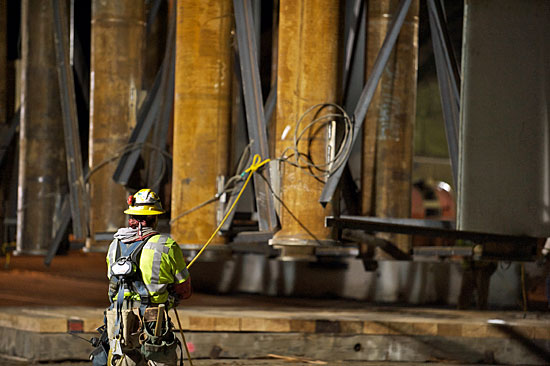

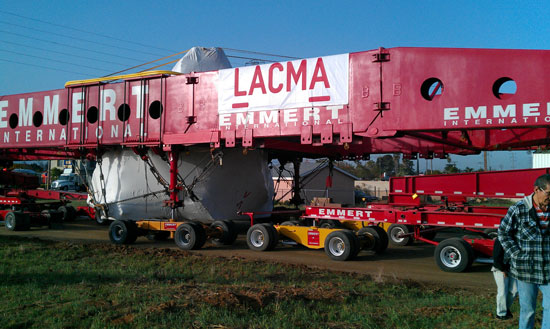
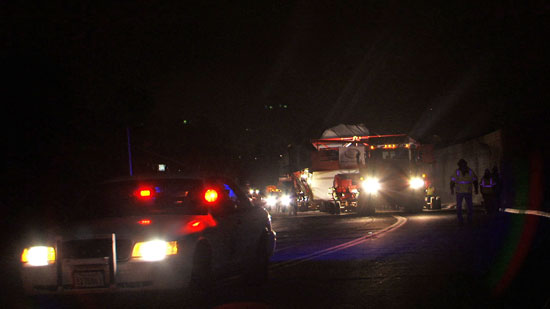





 Check for the latest closure information
Check for the latest closure information








